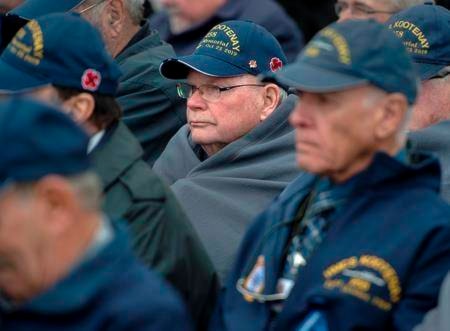HALIFAX — Allan “Dinger” Bell has no idea how long he was in the flames that engulfed the HMCS Kootenay engine room after the destroyer was rocked by an explosion that led to the worst peacetime accident in the history of the Royal Canadian Navy.
Bell was one of 10 men on duty in the engine room 50 years ago when a bearing in the starboard gear box failed, causing the explosion on the morning of Oct. 23, 1969.
Only three of them made it out alive.
“It happened too fast for it to be a shock — time was going so fast it stood still,” Bell said at a Halifax memorial ceremony Wednesday, describing the experience as “hell on earth.”
“I don’t know how long I was in the fire,” he said. “You had … men burning to death, and they wanted to live. It wasn’t a sweet place to be.”
In total, nine crew members were killed and 53 others were injured as fire and toxic smoke filled the vessel, which had been conducting a full-power sea trial in waters off Plymouth, England.
Bell, who was 21 at the time, sustained third-degree burns to nearly half his body.
The 71-year-old Dartmouth, N.S., resident, who was awarded the Canadian Armed Forces Wound Stripe earlier this year, was one of dozens of former crew, families, and dignitaries who attended the ceremony marking the anniversary Wednesday at Halifax’s Point Pleasant Park.
John Montague, a retired navy captain, was a junior officer aboard Kootenay during the disaster. He described the scene on the stricken vessel for the assembled crowd.
“The smoke was so thick and travelled so quickly even the bridge had to be evacuated,” he said. ”The heat from the fire was so intense it actually melted an aluminum ladder in the engine room.”
Montague said there was so much damage in the initial stages following the explosion that the main engine couldn’t be shut down, meaning Kootenay continued to steam ahead “at full speed and completely out of control.”
“Even our communications system was unserviceable and there was no way to contact the other ships in the flotilla since they were over the horizon and completely out of sight.”
Montague said it took about two hours to bring the fire under control, and during that time the crew distinguished itself with numerous acts of “extreme bravery.”
At one point, three of the ship’s divers strapped on their scuba tanks and went below decks to assist in the rescue operations.
One of them was John Womack, who was a 20-year-old able seaman at the time.
“You couldn’t see, and it was hot,” said Womack, who helped pour foam into the engine room from a deck above it.
“We had to exchange (tanks) because the regulators on our diving tanks would get gummed up after 15 minutes, so they had to be cleaned.”
Other ships that were part of the exercise eventually came to Kootenay’s assistance, including Canada’s last aircraft carrier, HMCS Bonaventure.
Rocky Thorne, a cook aboard the Bonaventure, described what he saw as his vessel came alongside Kootenay.
“The side of the ship had completely mushroomed out — the metal — and there was smoldering stuff coming out,” Thorne said. “We started sending over (fire) attack teams because they were exhausted.”
Kootenay was eventually towed back to Portsmouth, U.K., where it was dry-docked. Its propellers were removed and the ship was towed to Halifax, where it arrived on Nov. 27, 1969.
Following repairs the vessel was re-commissioned in 1972 and it served on the West Coast until 1995. In November 2000 Kootenay was towed to Puerto Vallarta, Mexico where it was sunk to become an artificial reef.
Its legacy remains the lasting improvements to firefighting and damage control practices in the navy following the disaster, along with the heroic actions of crew members credited with saving lives and the ship itself that day.
“A less professional crew could easily have finished the day off in life rafts,” Kootenay’s commanding officer Cmdr. Neil Norton later wrote of the disaster.
This report by The Canadian Press was first published Oct. 23, 2019.
Keith Doucette, The Canadian Press
